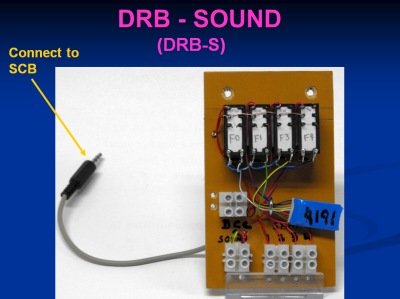<BACK Sound
Why Sound?
As the layout developed, sound was present in the form a very few sound-equipped locomotives. But somehow, this didn’t present the degree of realism that was imagined when the layout was planned.
The first venture into sound was on the four circus modules. A variety of circus- and carnival-themed songs was recorded on an early MP3 player, that player was connected to a pair of computer speakers behind the modules, the MP3 player was set to repeat and it played “music” all day long, for a 2-day show!
With this background, the concept was transported to the main layout and, over time, more and more sounds were added. Some were computer-based and some were based on ITT modules. Some had powered speakers under the layout for “larger” sounds (covered a wider area), and some had non-powered speakers on the layout (for a more “localized” sound).
This was all integrated using JMRI to control when, where, and which sound played.
The system is developed in individual pieces, any one of which could be replicated by itself.
Sound deserves separate mention since it is such a versatile and complex system. There are four types of sounds used on the layout:
1. Conventional DCC decoder sounds, normally used in a locomotive to produce engine noises, bell, horn, exhaust sounds and all the standard functions.
2. Hardware-generated sounds which are special electronic modules designed specifically to produce a certain sound effect to be played by a speaker which is usually on the layout.
Innovative Train Technologies (ITT) makes a product line of electronically produced sounds and these can be activated by wiring them to a speaker and turning on the power to the module. This includes railroad crossing bells sound which can be wired to a small speaker on the layout near a crossing and is typically used together with an LRT Grade Crossing Pro which produces the flashing lights to accompany the crossing bell sound effect.
Logic Rail Technologies (LRT) makes a product line which includes grade crossing animation (flashing lights, train detection), and many other items.
3. Computer-produced sounds are sounds that are recorded and translated to a .wav format and played using JMRI through the computer's sound system.
On RHJ Rail, this is a whole subsystem which uses the sound card line-out to connect to a custom designed sound distribution board which, in turn, uses a number of DCC-activated relays to connect the sound line to a specific speaker or set of speakers on or under the layout.
4. Telegraph sounds are, at present, of two types.
In the first type, a telegraph message is sent to a real telegraph device, recorded (on a smart phone), copied to a computer, translated and edited to a .wav file and played through System 3 above.
In the second type, a DCC decoder is used with special scripts to translate a written text message to Morse Code and play that message using a standard (non-sound) DCC mobile decoder by rapidly flashing an auxiliary function output of the decoder.
This output would normally be used for something like the headlight or marker lights on a locomotive but for this purpose, it is used to drive a fast-responding relay. This small relay can be used either inside a station on the layout, where the relay is pressed hard against a wall of the station to amplify the clicking sound it makes when turning on or off, or to drive a larger-current device such as a real telegraph sounder.
It turns out that a JMRI script can turn a decoder function on and off much more quickly than can a hand-held throttle, thus a sequence like a Morse Code signal can be created effectively at a speed comparable to the real thing.
One has to wonder, how many DCC model railroads have a working telegraph system, especially one with a real telegraph device as one of its options?
General set-up for Digitrax DCC Sound LayoutSpecial Effects Controls
To facilitate in the automatic operation of special effects, including sound, several custom-designed gizmos have been developed. Except for the Sound Control Board (SCB), these are based on mobile decoders and relays. Standard effects which operate by just turning something on and off typically use a Decoder Relay Board (DRB) which is described on Technical - Page 5.
Sound Control Board (SCB) - This is a special board that uses input from a computer sound card (line-out) and it can adjust the volume and provide amplification. This was made from an inexpensive (free) pair of computer speakers by removing the controls found on one speaker of the pair and mounting them on a board under the layout convenient to the computer sound output. This board then provides sound output to a sound distribution board, DRB-S, for deploying sound around the layout.
Decoder Relay Board-Sound (DRB-S) - The DRB-S is a special version of the standard DRB. The sound version simply uses both poles of the DPDT relay to provide the capability of stereo sound being distributed around the layout.

continued on Technical - Page 7
More details on any of the above can, of course, be obtained by contacting RHJ Rail.
RHJ Rail is owned and operated by Richard H. Johnson
© Copyright 2025 Richard H. Johnson


